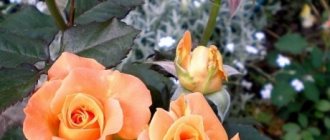There are many varieties of miniature roses. One of them is Cordana rose mix. This royal flower can be grown both in the garden and at home. Among lovers of small plants it is considered one of the favorites. In order for the flowering of the Cordana rose to please connoisseurs of decorative flowers, it requires quite responsible care. But the result will exceed expectations. The result will be the true beauty of the flower.
Basic information about the variety
The height of Cordana's rose is no more than thirty centimeters. Its distinctive feature is lush and dense greenery and a large number of small buds of the usual shape. The leaves have a rich emerald color. There are different colors of the flower: white, pink, red, yellow. Rose blooms will bring joy throughout the warm season - from May to October.
It is noteworthy that this type of rose does not emit any fragrance at all. The fact, of course, is not very happy, but people are not at risk of allergies from it. Such a rose can be given as a gift without any risk, and indoors it will not cause harm to health.
Cordana rose height
Treatment of diseases
Like other indoor plants, the Cordana rose is quite often affected by a variety of diseases and insect pests. The crop can become sick from mechanical damage to the roots during transplantation, due to watering with cold water or strong drafts (Figure 7).
Note: The first symptoms of disease appear when the crop drops its leaves or the plates begin to turn yellow. If you notice such signs, you need to take immediate action. Otherwise, the rose leaves will begin to curl, and over time the crop will dry out completely.
Yellow leaves indicate not only a lack of nutrients, but also a fungal infection. To cure a flower from powdery mildew or other similar diseases, you need to remove the parts covered with a white coating with fungal spores, and spray the crop itself with preparations containing copper.
Figure 7. If not cared for properly, the flower may get sick.
Of the pests, the flower is most often affected by spider mites. This insect is so small that it is not always possible to notice it on time. However, if you notice black or red spots on the surface of the leaves or stems, immediately spray with special chemicals. In addition, it is highly desirable to increase the humidity in the room, since the spread of spider mites is facilitated by increased dry air.
Keeping Cordana roses indoors
Before being sold, the rose is packed in a peat ball. Such a base will retain moisture for a long time, which will allow the seller to reduce the amount of care for the plant - for obvious reasons, the store does not provide individual attention to each flower. However, such land is not suitable for constant cultivation of Cordana mix, so soon after purchase the rose will need to be replanted. And initially she needs to adapt to the new order of living. The “getting used to” process lasts from 10 to 12 days.
During the first time after purchasing a rose, the plant may lose some of its foliage, which is a common occurrence.
Having bought a rose and delivered it home, it is necessary to provide it with favorable living conditions in a new place as quickly as possible, even if initially all the buds on the bush have to be removed. Before new shoots form, the Cordana rose will likely shed some of its foliage and may even turn yellow. There is nothing terrible here, and the bush should not be prematurely considered dead. This is a common occurrence, and fresh shoots and leaves will certainly appear within a couple of weeks. At the same moment, new roots will grow.
Lighting requirements
Miniature roses do not tolerate heat, cold or direct exposure to bright sunlight. And the lack of light negatively affects its growth and flowering. Therefore, a pot with a bush is placed on the window sills on the south or southwest side. When the peak of solar activity occurs, the plant must be moved to the shady side so as not to cause burns. The lack of natural light is compensated by artificial light: for healthy flowering, a rose requires light at least 12 hours a day.
Rose at home
Temperature for growing roses
In summer, the maximum air temperature for a flower should not exceed 20–23 degrees. In hot weather, it is generally better to move the pot with the plant to the loggia or garden. In winter, in the room where the rose is grown, the air temperature should be maintained at a level of at least 15 degrees. The flower will fully develop if there is fresh air in the room, so it needs to be ventilated regularly. During this procedure, it is advisable to take the pot out of the room.
Particular attention should be paid to the air temperature of the room in which the rose will be located. It should not be higher than 20–23 degrees.
Rosa Cordana mix should not be grown near central heating radiators and other heating devices, because there is very little fresh air in these places. If this is not possible, then between the flower pot and the source of warm air you will need to build a partition made of foil or thick cardboard.
Air humidity while growing roses
Cordana mix does not like low air humidity. Its response will be slow development and a clear reluctance to bloom well. Therefore, the process of caring for a rose also involves constant maintenance of high humidity, which is achieved by weekly spraying of the foliage. For this procedure, you must use only warm water, because cold water can provoke powdery mildew, an unpleasant fungal disease.
Low air humidity and cold water are detrimental to the Cordana mix rose.
During a quiet winter period for the plant, only the air next to the bush is humidified, without touching it. And in the spring, when the rose begins to awaken, you can please it several times with a good shower, again with warm water. The rose should not be allowed to have indoor drafts, otherwise it can be damaged.
Powdery mildew on rose leaves
Watering recommendations
In summer, the plant should be watered abundantly and systematically. The optimal time for watering is early morning or late evening. The need for watering is determined by simply pressing your finger on the surface of the soil. If your finger is not moistened, then it’s time to moisten the soil. Water may leak into the pan; it should be poured out immediately to prevent the soil from souring. It is preferable to bring water for irrigation to room temperature. In the room, liquid is poured under the root of a flower.
If you have to leave for a long time, you still have to pour water into the pan. Then the plant will be able to drink moisture for about a month and a half and will not dry out. Before the onset of winter, watering is done 1-2 times a week, then the procedure is reduced to a minimum. At the end of watering, the soil is loosened to ensure the penetration of oxygen to the roots of the plant.
Nuances of care at different times of the year
Plant care directly depends on the seasonal factor
It is definitely worth taking into account
in spring
During this period, the plant develops new leaves and shoots. In this case, you need to carefully care for the bush. It is recommended to increase the number of waterings and use mineral preparations. It is also recommended to feed the rose with organic substances. Solutions of mullein or bird droppings work well.
In spring, the plant should not experience a shortage of water or lighting. In the evening, you can spray the crop with cool water. After the end of spring frosts, you can move the pot to the balcony or outside. The plant should be accustomed to the sun's rays gradually. At first it is placed in the shade and only after 10-14 days is it brought out into the sun.
In summer
In summer, the rose should be frequently watered, sprayed, and fertilized. It is also necessary to remove wilted fragments of the bush in a timely manner.
To avoid overheating of the bush in hot weather, it is important to control its condition.
in autumn
When the temperature drops to +12-15 degrees, it is recommended to bring the rose indoors and place it on the south side. After flowering is completed, it is worth starting to prepare the bush for winter. In this case, the number of waterings should be reduced. The soil should remain dry for 1-2 days. It is worth gradually reducing the amount of fertilizer.
Before wintering begins, the bush should be pruned. There should be 5 buds left on each branch. However, the leaves should not be removed. It is recommended to perform pruning in the evening. If you neglect this stage, next year the plant will bloom worse, and the bush will take on an untidy shape. If autumn pruning was not performed, the procedure is postponed to spring.
What you need to know about soil and pot for roses
Any flower shop sells special soil for Cordana. If you want to prepare the soil yourself, you will need to mix turf soil with peat and sand in a ratio of 2:2:1. There are plenty of them in mineral components, which will cause the rose to suffer. Before disinfection, a little granular fertilizer is added to the composition.
Before planting, the mixture must be disinfected, otherwise the plant will be attacked by pathogenic microbes.
Rosa mix prefers ceramic pots with a glazed inner surface. With its size, the pot should not restrict the roots, leaving them a space of 2–3 cm. Drainage holes must be made in the container. The pot must first be immersed in heated water for two hours. The material will be saturated with moisture and will no longer absorb water from the soil.
Auspicious pots for roses
Video on the topic
We invite you to watch a video about the Cordana rose and its care:
If you find an error, please select a piece of text and press Ctrl+Enter.
Indoor roses are among the rather capricious plants that require more careful attention than their garden counterparts, since the microclimate of city apartments is a greater test for them than the impact of weather conditions when grown outdoors. Another factor influencing the well-being of this delicate crop is the very limited space of the flower pot.
The most common problem that baffles inexperienced gardeners is the drying out of beautiful bushes, which just yesterday delighted with abundant flowering, but today have begun to shed their leaves and are rapidly losing their decorative value.
Why do indoor roses dry out in a pot and is it possible to prevent the death of the plant? The answer to these questions can be found in the following sections of our article.
Bush transplantation and propagation technology
The rose must be replanted after its purchase, and also as needed. For example, when it becomes obvious that she has outgrown the size of the pot. The most favorable mix for Cordana will be transplantation during the waxing phase of the Moon. To make the plant take root faster and easier, you should first trim all the buds. There is no need to feel any pity: after a short period of time, the flower will bloom new ones. To transplant a miniature rose, you need to do a few simple things:
- Drainage made of pebbles or brick chips 1 cm thick is placed at the bottom of the pot. There will be pores between the particles of the material that will quickly let water through. The drainage is covered with a small layer of soil.
- The rose is removed from the pot in which it was purchased with the utmost care: the peat ball should not be destroyed.
- The bush is moved inside a new pot slightly larger than the previous one. The resulting voids are filled with soil. To compact the added soil, simply tap lightly on the sides of the pot.
- After transplanting, the foliage is sprayed with warm water. The plant itself does not need to be watered.
- The transplanted rose should be left in a dark place for about a day.
- When the next day arrives, the flower pot should take its permanent place.
If the transplant is not related to the purchase of a rose, then it is advisable to carry out a similar procedure in the spring, when signs of plant growth become noticeable.
Rose Cordana is propagated by cuttings, which can be taken from May to August inclusive. For this, healthy and thick stems are used. The sequence of actions is as follows:
- The cuttings are cut, each of which contains 2–3 internodes;
- The cuttings are placed in a container with water, and a root formation agent (for example, Kornevin) is added there;
- During the process of root formation, the water in the vessel does not change;
- When the root length reaches 2 cm, the cuttings can be transplanted into the soil;
- At first, young bushes should be protected from the sun.
When new shoots appear, you can begin regularly fertilizing and watering the soil. Spring accelerates the growth of cuttings, and they can bloom within a month. You can grow a rose from seeds, but it will be a longer process.
Types of domestic roses
Below is a popular indoor rose (types, photos and names):
- Polyantha - has the appearance of a low bush, on which small flowers of white, pink and red tones are densely located. They bloom all year round, but are scentless.
Remontant - endowed with dense dark green foliage, a long peduncle with buds resembling the shape of a glass. The rose has fewer buds than the polyanthus, but it pleases with flowering twice a season.
Bengal - compact and unpretentious, with small leaves decorates the interior throughout the year with lush red, white and pink flowers.
Rose Cordana is the most capricious, but beautiful plant with lush greenery and varied colors, reaching a height of up to 30 cm. It has no aroma, so they are often bred by people with allergic reactions.
If you like the Cordana rose, you need to carefully care for it, because during the first 2-3 weeks it will be difficult for it to get used to new conditions: it often drops all its leaves and buds. If you take care of the plant, after 30 days it will turn green again and will bloom from May to October.
The bush should have smooth and shiny leaves without signs of wilting. If there are spots on them, then there may be a fungal or bacterial disease. Rosa Cordana loves a sunny place, but it needs to be protected from burns. Comfortable temperature – 15-20°C. Watering should be done regularly and abundantly, but avoid stagnation of water. Gardeners argue about whether spraying is necessary for a capricious rose. Most believe that it leads to flower diseases. If you ensure proper watering at home and without additional spraying, the flower will feel good and bloom.
Pruning rose Cordana
There is no excess growth on the Cordana rose, so young shoots are saved to replace old branches. 3-4 buds are left on adult and young branches, the rest is removed. There should also be no crooked, frail shoots growing inside the bush.
Roses are propagated by cuttings in May-August:
- cut branches with 3-4 live buds;
- put them in a container with water and a growth stimulator;
- When roots (2 cm) appear after 10-15 days, the cuttings are planted in pots.
Seasonal work with roses. Additional care tips
For rose Cordana mix, there are seasonal features of the maintenance of the plant or its life activity:
| Spring and summer | The plant requires periodic feeding. In the spring, it is preferable to use nitrogen-containing compounds, and in the summer - potassium-phosphorus fertilizers. By the end of the summer season, saltpeter can be added to the fertilizer. |
| Autumn | Mandatory pruning of roses is carried out. Not only adult branches are cut, but also young shoots. It is enough to leave a few buds. All weak, crooked and brittle shoots must also be removed |
| Winter | For roses, winter is a period of rest. It practically stops blooming and loses a significant part of its foliage. The plant needs rest. It is moved to a place with moderate temperatures, and returned back in mid-February. |
Every owner of a rose wants it to please with its flowering for as long as possible. One of the best solutions to this issue is to place the flower pot in a well-lit place and provide a constant flow of fresh air. In such conditions, the Cordana rose will not remain in debt and will bring joy for many years. And general plant care will not cause any trouble, because it will be a pleasant pastime.
Pests and diseases
Cordana's rose can be affected by spider mites. In this case, the plant is treated with a special anti-mite preparation according to the instructions.
Rosa Cordana
You can detect spider mites by carefully examining the leaf. On its reverse side there will be a characteristic white coating. Also, rose foliage when affected by mites becomes deformed, turns yellow and falls off over time.
Important! If a spider mite is detected, the rose is treated with a special preparation 3-4 times a week.
The tick is capable of developing very quickly, releasing a new generation every 3-4 days. Folk remedies are good for pest control: garlic tincture, solution based on laundry soap.
Roses can also be affected by powdery mildew. Leaves affected by this disease have an ashy coating. The disease should be combated with antifungal drugs and care for the plant more carefully (do not overwater, do not overfeed).
Attention! It is better to choose systemic agents, as they fight the disease not only on the surface, but also from the inside.
Cordana mix in the garden. Features of care
Rose bushes will perfectly decorate a garden plot in border plantings located along the alley paths. The low plant looks great in the foreground of landscape compositions. But neighbors such as rhododendron or hydrangea Cordana are not at all happy with the mix.
Cordana mix in the garden
The first step is to find a convenient place for the rose bush. If there is a small plot of land on the southwestern or southeastern side of the site, then the territorial issue can be considered resolved. The main work for caring for a flower is as follows:
- Before planting the bush, the soil is watered abundantly and a nutrient solution is added.
- After planting a rose, it is closely monitored for the first time. The soil will require loosening and fertilization.
- As necessary, the flower is sprayed with settled water at a comfortable temperature.
- Before the onset of winter, all buds are cut off. The remaining cuttings are used for further propagation of the plant. The bush is sprinkled with sawdust and protected from the effects of adverse weather factors: covered with burlap or other suitable materials. In too harsh a climate, it is advisable to dig up the rose and, together with a lump of earth, transfer it to a home pot until spring.
It is not for nothing that the miniature rose is in great demand among gardeners and ordinary lovers of beautiful plants. Proper care of Cordana mix, following all the rules, will allow you to tame even such a capricious flower. And it will definitely bring joy for a long time with its beautiful blooms. In a pot, a rose will become an unsurpassed beauty, each time proving that it is not in vain that it is considered a symbol of love and greatness.
Selection and description
The Cordana variety was obtained by selecting dwarf varieties of tea roses brought from China at the beginning of the 19th century.
The author of the new potted plant is the famous flower breeder Wilhelm Cordes, in whose honor the miniature rose got its name.
The compact rose flower bush is demanding in terms of growing conditions and care. Therefore, before growing Cordana roses, you must carefully read the detailed description of the plant.
- Mature bushes are small, reaching a maximum height of 25-30 centimeters.
- The plant is covered with dark green leaf blades, the shape and structure characteristic of this crop.
- The period of rapid flowering begins in mid-spring and continues until the end of autumn.
- The buds are of a standard shape and structure, the color is varied, depending on the variety and variety of the plant.
Reference! Miniature roses take root well at home and in the open ground of gardens and summer cottages. Used for planting flower beds, flower borders and creating landscape design in personal plots.











